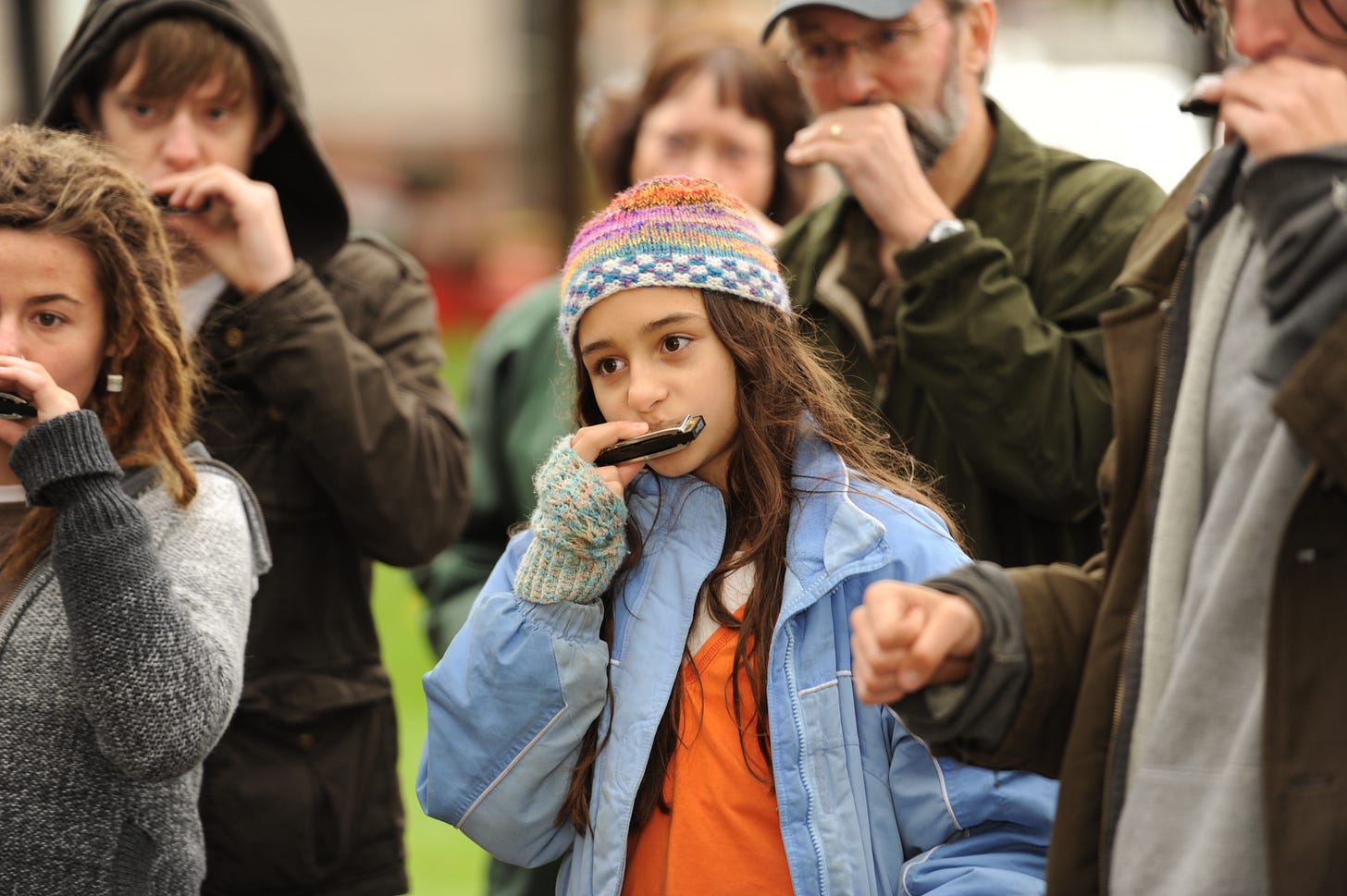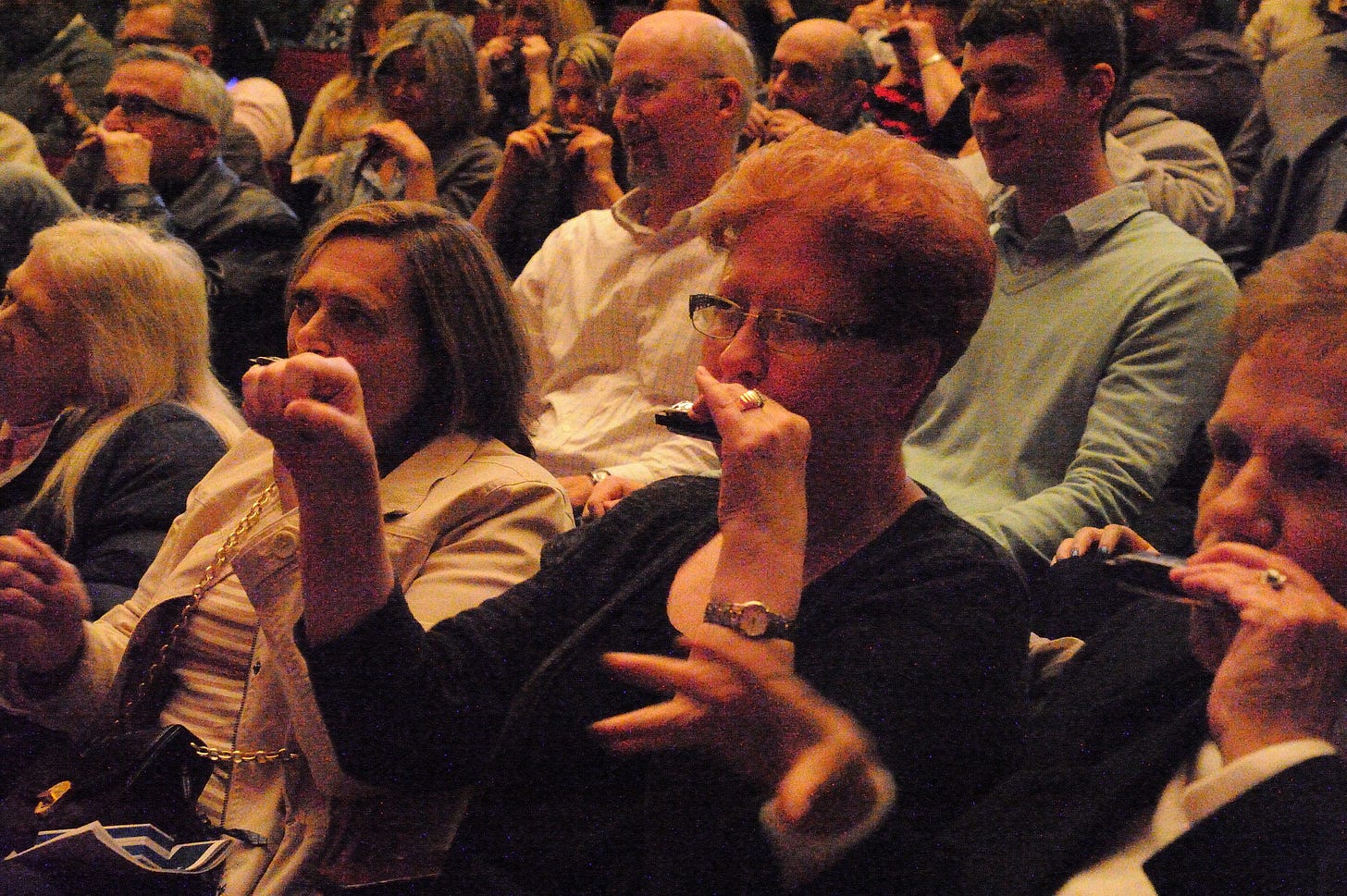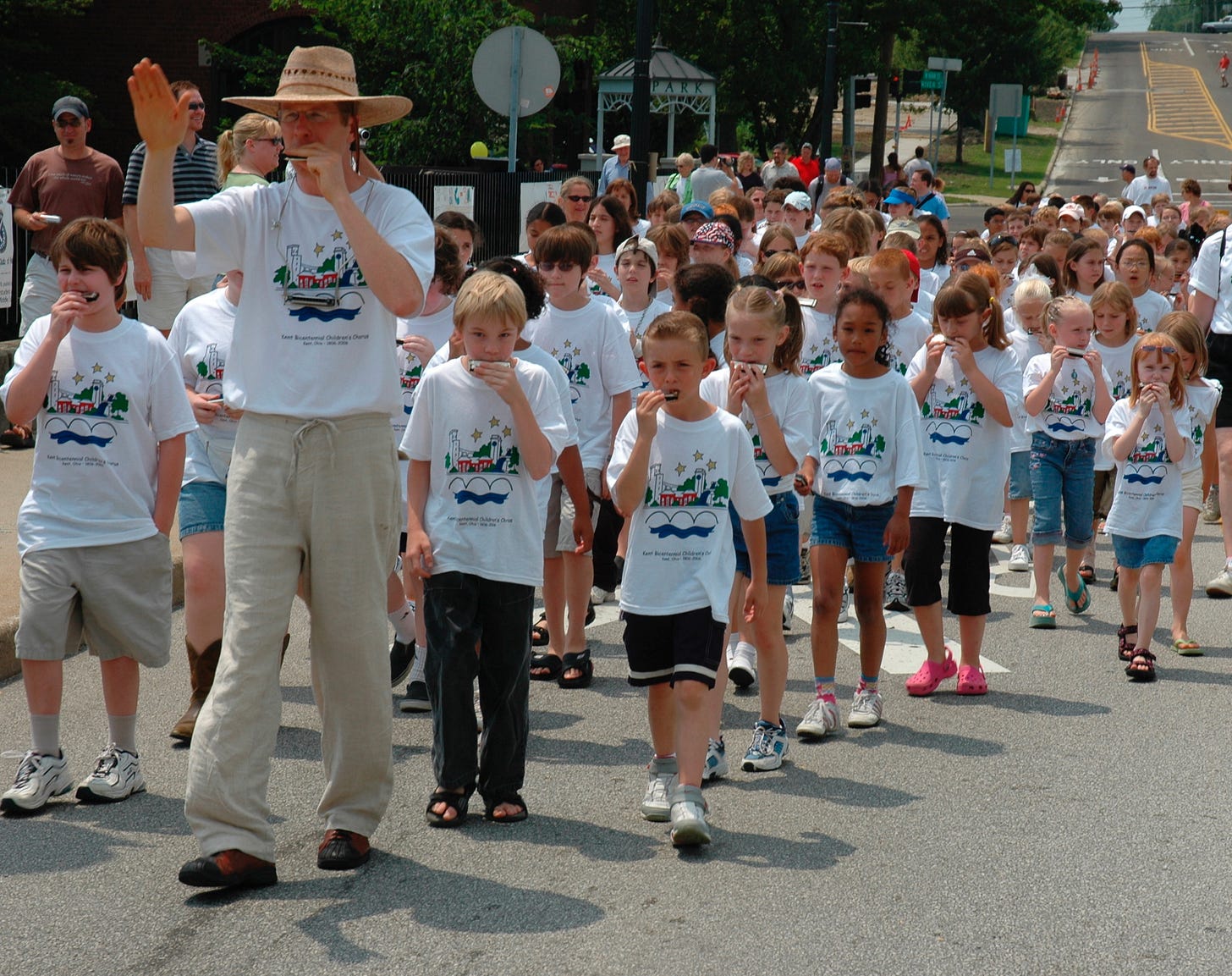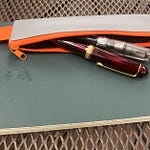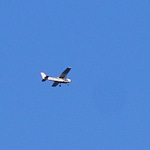Hi. This episode is intended to be consumed as an podcast. Press PLAY above for narration with musical examples. (22 minute listen) You’ll find a full transcription below. Enjoy. Hal
The Harmonica Revolution
We want more harmonicas! More music in the streets!
We want more harmonicas! More music in the streets!
You know, eventually we all got to face it.
We got to face the fact that we don't get all the things done that we wanted to get done. Everybody's body eventually… fails. (lol) Yeah, that's a good note to start this off on. Everybody's body eventually fails and all the getting things done comes to an end. We all gotta face it eventually. Yeah, that's the trouble with living in a body. Eventually it doesn't work anymore.
All the plans I had, all the big projects in my head, all the dreams, all the big ideas, all the revolutions I was supposed to make happen. The body fails and some other part of us has to take over — something beyond the physical realm. But I'm still attached to the world and some of my favorite projects probably aren't going to get done. We all got to face it eventually. But here's a little bit of my list…
Like — the Hal Walker song book, the video series for teachers about how to bring Banakula making and playing into the classroom, the how to play “Low Key Gliding” instructional series, re-recording all my songs at a more reasonable tempo because I was too high on adrenaline the first time around, learning the Chuck-a-chucks, learning the cello, learning jazz piano, and writing all those songs that never got written — all the undone projects. Now, I'm not saying none of this is ever gonna happen. I realize that 10 minutes a day of focused attention can accomplish a lot, but I'm over here giving it all I got just to take care of the basics. There's not a whole lot of extra for revolutions.
I'll take one step forward today, and I want to tell you about one of my biggest ideas. It's the Harmonica Revolution of the 21st Century, which was one of my greatest unfinished contributions to humanity. Here's a little song about it, “Ode to the Harmonica.” (To the tune of Ode to Joy)
Playing the harmonica I often feel a certain glow.
With this notion of hand motions, everything is draw and blow
Music comes from deep in the belly, deep in the heart and in my soul.
In my pocket, a harmonica will go where’er I go.
For many years, I worked with children, teaching them to play the harmonica. I passed out thousands of Blues Band harmonicas all around the state of Ohio and I did most of my teaching in large group settings. I’d teach a whole classroom or a whole grade level or a whole school. You know, I don't remember what the biggest group was, but it was large groups. It was mass harmonica instruction. Each kid with a harmonica in their hand getting a foundation for a lifetime of harmonica playing.
And it wasn't just kids. One of the highlights was teaching prisoners at the Mansfield Penitentiary. It was me in a gymnasium teaching the blues to a hundred hardcore prisoners. I was in the middle of a big huddle of guys playing the “Sesame Street Blues.” It was amazing.
Over the years, I developed a highly effective method for teaching the harmonica to large groups of people. And I'm certain no one had ever done it like this before. It was an original method. And with as much humility as I can muster, it was the best method ever. It was highly effective. If you really want a foundation for a lifetime of playing the harmonica, use this method. Unfortunately, it's not available. The teacher came down with a nasty case of ME/CFS and never got the method packaged for your consumption.
But you should’ve seen us. Students had amazing results making real music on the harmonica within minutes and within days. We had so much fun in schools all around Ohio, lessons that these kids will remember for a lifetime. And I loved it. I loved it so much. (lol) It was so fun! It was so fun teaching the harmonica this way. I never really came up with a perfect name for the method, but it was “The Harmonica Revolution.” It was “Music that Fits in Your Pocket,” a foundation for a lifetime of playing the harmonica, based on two choices — blow and draw.
You know, it occurs to me to mention that nowadays, as far as I can tell, not many people are playing the harmonica. There was a day when the harmonica was like the national instrument of the U.S. In my recollection, every kid had a harmonica in his pocket. Every grandfather played the harmonica for his grandchild. I did my little part here in Ohio to bring harmonicas back into the daily lives of children everywhere.
That’s the Harmonica Revolution — one of the projects that I have not yet finished. I think in schools these days, some kids learn the recorder. But what I wanna say is that I think the harmonica is the ideal instrument for the classroom. It costs less than five dollars, it fits right in your pocket and within minutes, you can be making cool, satisfying, real music — especially if you've got my method. I guess that's the unfortunate part. Thanks to ME/CFS, this method is not available to schools all around the world. It should be. Boohoo.
Probably the best and most recent example of my success with this method was in that one town… Bucyrus, down in Crawford County. It was Bucyrus elementary school. I was over there and I had a year-long residency. I’d drive there once a week. It was a two and a half hour commute. I left at like five in the morning and in all my mild ME/CFS glory, I'd spend the day there, giving everything I’ve got to this school. And one of the grades, I think it was the third grade, we did mass harmonica instruction. There were probably at least a hundred kids in that class. Every week we would meet in the gymnasium — a harmonica in every hand. Their chairs were lined up in rows theater style. I asked the teachers to give me full classroom management. The last thing you want is a bunch of teachers out there trying to “shush” the kids. I had my own methods. So I brought along my almost 20 years of refining this teaching method and by the end of the year, those kids had a powerful foundation for a lifetime of blowing the harmonica.
And I want to share a little bit of my method now. It's so hard to talk about. You have to see it. You had to be there. You had to be there! But I'm gonna give it my best. All right, here we go…
The foundational principle of this method is: in all beginning harmonica playing, there are only two choices, blow and draw, push and pull. And before we ever picked up harmonica, these students would master the push and pull of the diaphragm using hand motions. Actually, it was arm motions. Actually, it was using full body motions — pushing and pulling.
Learning the harmonica is a full body kinesthetic experience of breathing to make music. Before I ever put a harmonica in their hands, I'd say “blow, draw blow.” And they'd repeat, “blow, draw blow.” And rule number one was “hand motions at all times.” Every time they say blow, with their whole arms and their hands and their shoulders, they're pushing. And every time we say draw, with their whole body, they're pulling. Then there's old Hal Walker up there over the course of about 20 years, putting his whole body and spirit into these full body harmonica lessons.
I had this hilarious gimmick that worked every time. I would push and pull so dramatically that I would accidentally, on purpose, slide into the splits and call for the front row to save me. And they would rush around me and pick me up and lift my whole body, to save me from falling into the splits. (lol) It was hilarious.
After we mastered the “push, pull, push,” or the “blow, draw, blow,” we'd speed it up and make it more exciting, like this. “Blow-D-Blow Blow Blow Blow” etc…
Remember, hand motions at all times and the students repeat exactly what I do. It was all “I go, then you go,” illustrating the push and the pull of the diaphragm. I wouldn't even hand out the harmonicas ‘till at least the second lesson. It was my theory that I could teach for a whole semester using just hand motions and these students would become great harmonica players — without a harmonica in their hand. I never actually tried it, but I'm still convinced it would work. Starting with hand motions was fun and accessible, not intimidating. It was like a dance that everybody could do.
Now, here was the key. From the very beginning, those kids are at the edge of their seat. I demanded it from day one — at the edge of their seats, back straight, feet on the ground, mastering the blow and draw. The number one rule was “hand motions at all times.” It's funny. This is all coming back to me now, but it's been years since I've even thought about this. I've been so deep in the illness of ME/CFS.
So… from the beginning, these kids learned who was in charge, and the beauty was, they seemed to be grateful that it was me. We had so much fun together.
While I was developing this harmonica method, I was also developing a highly effective method of large classroom management. And I'll tell you what it was right now. One thing I didn't do was make ‘em pay attention for forty whole minutes. We’d do little spurts of 5 to 10 minutes, right at the edge of their seats — highly focused lessons, very methodical, moving one step at a time.
And then I'd say, “let's take a break,” and that's what we do. I'd encourage them to relax, to talk amongst themselves and for two or three minutes, I would ask them to get as comfortable as they could in that chair. Like, pretend that chair is a bed and lie down in that chair and put your feet up if you want. You are totally free. You can laugh, you can talk to your friends. You can lie there quietly. You can do whatever you want, as long as you stay in your own seat vicinity until you get the signal, which is, (Sung) “cuckoo cuckoo” and immediately the class responds, “cuckoo cuckoo” and then they're silent.
We would go from total managed cacophony to pure silence in mere seconds — and I wouldn't stand for anything less. I made that very clear.
The teachers couldn't believe it. They questioned the chaos, but when they saw how fast I could bring them back to attention, they realized it was something special. It's hard to explain. I was just such a fun version of a military sergeant. It was my only option with a hundred third graders in a gymnasium with harmonicas in their hands. I was very strict and very fun. So after they mastered the hand motions, eventually I'd hand out harmonicas.
And that brought about the second rule, “no individual tooting.” You can toot whenever you want — at home, at recess, when you're on the playground toot all day long, when you're in your bedroom toot, you can toot as much as you want. But when we're in this classroom, there is no individual tooting. When we toot, we only toot as a group. I made that very clear and I said it with a straight face. And they looked at me and they didn't know what to think. There is no individual tooting, N-I-T. And I'd go and say, “What's rule number one?” I'd call a student out. He'd say, “Rule number one, hand motions at all times.” “What's rule number two?” “No individual tooting.” Because there's nothing worse than a hundred harmonicas and every once in a while, a little toot coming out of one of their harmonicas when you didn't want it. I wouldn't stand for a single toot. You did not want to be the kid that got called out for individual tooting. But it was all in good fun. It was all in good, playful, disciplined, productive fun — just the way I like it. And it worked. I had those kids eating out of the palm of my hands.
I loved whenever a kid did something right, whenever I noticed they got it just right — like if their hand motions were particularly expressive and right on the beat or their blow-d-blows were just right, I'd call them out. I'd go over and say, “What's your name?” They'd tell me their name. And I'd say, “Sally, it's a pleasure to have you in my class.” And then I'd shake her hand. Typically, for the first handshake, kids would give a really weak, flimsy handshake. So I'd take that opportunity to give them a one-on-one lesson in how to give a proper handshake.
I taught 1000s of students how to shake hands — “firm squeeze, small shake, look the person right in the eye.” And we would practice it right in front of the whole class. And every time a kid got a handshaking lesson, it was an honor. This student knew she'd done something right and every other kid wanted to do something right to get a handshake. And by the end of the semester, by the end of the class, they knew how to give a proper firm handshake.
Of course, that was before the COVID days when we were allowed just to shake hands at random. I got sick a lot. I mean, I'd shake these sweaty little hands. I shook so many hands and I was always carrying some hand sanitizer around, but it never did the job — all that handshaking. Every Friday, I'd go home and be sick for the weekend.
So eventually, they'd get a harmonica in their hands. And the first thing is, we don't worry about single notes. It's “wide mouth, big sound.” Put the harmonica deep into the mouth. It's called the “deep relaxed tilt.” So put the harmonica deep in your mouth, relaxed lips, covering the holes so no air is escaping, and tilt, tilt the harmonica slightly down. So with the “deep, relaxed tilt,” these kids would cover three or four holes, making a big sound, a full sound, breathing from the bottom of their belly, using the diaphragm, with a push and a pull. And the whole time, one hand's holding the harmonica, the other hand is doing the hand motions.
And then, the cool part about it was, I would ask another student to come up and lead the whole class in “blow-d-blows,” whether it be hand motions or blows and draws on the harmonica. I explained to them that along with learning to play the harmonica comes the responsibility of passing it on to the next generation. So, while they were learning to play the harmonica, they were also learning to teach the harmonica.
So, once we master the blow and draw, all in one place of the harmonica, like holes 1,2,3 and 4. Two options, remember, there are only two choices in beginning harmonica playing. We would move on to down and up and I'd start demonstrating how to go up and down on the harmonica. So now we had four choices — blow, draw, down and up.
The harmonica is all about making music with the breath. That's where it begins. I put off teaching single notes till much further down the road, so the students get used to making music right away, using hand motions, blowing and drawing, going up and down the scale. And then we'd start learning a song. The very first song was… (sung)
Do your ears hang low?
Do they wobble to and fro?
Can you tie ‘em in a knot?
Can you tie ‘em in a bow?
Can you throw them over your shoulder
like a continental soldier?
Do your ears hang low?
You know, the kind of sad thing is, I'm sitting here in my room and there's not a harmonica anywhere nearby. I went my whole life, I always had a harmonica nearby—in the car or in my pocket or on my desk, but they're all downstairs in a box. Someone’s gonna have to figure out what to do with them someday. It’s the brutal reality of ME/CFS. Of course. you never really know. But I’m pretty certain if the Harmonica Revolution were to happen tomorrow, I'm afraid I wouldn't be able to be there. But it's not happening tomorrow. It's not happening tomorrow or next week. But who knows? You know, I remember I had this plan, the “Million Harmonica March on Columbus” was supposed to happen in 2010. (lol) It never happened.
But teaching the harmonica was one of the great joys in my life. And coming up with this system, this method was such a delight and so satisfying. I guess the revolution would have been somehow making this system, or this method, spread all over the country, all over the world, revolutionizing music education. But here we are, living in a body, doing our best, facing the inevitable. Eventually, the body fails and all the getting things done comes to an end.
The Revolution becomes more of an inner experience, a more subtle kind of transformation. And we get to go along with the natural process. You know, we're part of nature and nature is so much bigger than all my revolutions. But we'll see where this leads. Maybe this post here will inspire some young whipper snapper to take up the baton and make this revolution happen.
All right. Thanks for listening, everyone. Thanks for hanging with me for this. It was fun to remember these times. Alright, enjoy. Enjoy living in that body of yours. Don't forget. Enjoy living in that body while you got it, because it ain't gonna be there forever. All right, everyone. I love you. Thanks so much. Bye.
For more Harmonica Revolution, check out the YouTube videos below.




